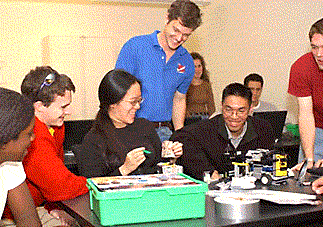|
 |
|
|
Christopher Rogers, standing, uses technology -- in the form of robots made from Legos -- to engage students in his freshman seminar. The reaction has been enthusiastic among humanities, science and engineering students alike. |
It was the start of a session of "Robots," a freshman seminar created by visiting professor Christopher Rogers to introduce students to concepts of engineering and physics. The class revolves around Tuesday competitions between robots that students construct from advanced Lego kits that include a small computer, motors, gears, light and touch sensors and other gadgetry. On Thursdays, Rogers introduces students to such subjects as mechanics and circuit design and lays out the ground rules for the week's competition.
"For the liberal arts majors, they see that the engineering stuff is not that scary," said Rogers, the Kenan Trust Visiting Professor for Distinguished Teaching in Mechanical and Aerospace Engineering. "For the engineers, they can see why they want to take the next two years of math and physics so they can actually do the engineering."
Among students in the class -- 13 planning majors in engineering or science and four considering the humanities -- the reaction is enthusiastic. "It's a dream," said John-Paul Mitchell. "This is one of the best classes that could ever happen. You work, but it's fun. It has everything."
"I really like that it's so different from anything else I am taking," said Morgan Galland, who is leaning toward a major in the humanities. "I had never taken physics before. Now I am learning some physics in a class that's really interesting, and I'm having a lot of fun doing it."
Applying principles
In week four, the assignment was to create a "bug" and a "bug catcher." The only requirement for the bug was that it move, if only very slowly. Solutions for the catchers ranged from the spartan Mr. T, which had no way of detecting the bug but drove in big loops that were likely to circle it, to a complex robot that used light and touch sensors to track its bug and snare it with crab-like pincers.
As the students filtered into the Friend Center classroom, they began making last-minute adjustments, but also looking with open admiration at the creations of their competitors.
"Some of them are so elaborate I almost feel guilty but not quite," said Ethan Clarke as he looked over the entrants. Clarke helped create Mr. T and its victim bug along with classmates Nate Domingue, Sameer Sharif and Mark Spano.
"We are really good at finding the simplest solution," said Domingue.
"You mean you're really good at defeating the purpose of the assignment!" another student interjected.
"No, we finished it," Domingue insisted. "Isn't the goal of engineering to do the job as efficiently as possible with as little material as possible?"
Seeing others apply the principles from the lectures often brings the point home best, said Wren Yang. "We'll walk into class on Tuesday and say 'Wow I didn't even think of that. That's just plain cool. Now how do I fix my robot in the space of this one hour so it can be cooler than that one?'"
The competitive spirit also carries students through the lecture sessions. "I learned about torque and gearing in physics class, but it wasn't fun because I didn't apply it," said Yang. "But here we want to learn everything because if we learn it well it will help us beat everyone else in the next competition."
The power to motivate makes robots a great teaching tool from kindergarten to college, said Rogers, who, as a faculty member at Tufts University, worked with Lego to develop robot kits, which the company now markets. The project is part of Rogers' broader effort to combat what he sees as a lack of attention to math, science and engineering in primary schools.
"Kids, from day one, love to build stuff," said Rogers, whose main research is in fluid dynamics. "If we can use that love for building to teach them math, science, engineering and even reading and writing, it could be a lot more powerful than (just teaching reading)," he said.
Engaging students with technology remains important in college, he said. "The average graduate from high school these days has woefully poor self-esteem when it comes to taking things apart and figuring out how to fix them," said Rogers. "In this class, they realize they are able to do it, that they can figure it out, that they take things apart and understand how they work."
In the bug-catcher challenge, no clear winner had emerged after several rounds. Rogers ordered an impromptu winner-takes-all finale with all the catchers racing for a single bug. The students stood in a ring cheering their creations. One catcher quickly hit the bug and efficiently lowered its box-like cage over it. "That bug is seriously caught," acknowledged a student whose catcher was floundering. Meanwhile, Mr. T doggedly circled. A fresh cheer rose from its partisans as, for a moment, it looked as though the mic cord would lasso the whole group. Then Mr. T ran into a wall.
Rogers handed out the victory prize -- a programmable odometer that feeds the robot information about how far it has traveled -- to the team of Yang, Mitchell, Allen Hsu, Olachi Opara and Christopher Rogan.
But class was not quite over. Rogers grew serious for a last announcement: It had been a poor showing the previous week at the Frisbee game that he instituted after every Tuesday class. A group soon assembled on the green in front of Fine Hall. Rogers heartily urged a visitor into the game. "It's educational," he said, stripping down to gym shorts and heaving an opening throw to one of his students. "It's all about fluid dynamics."
top